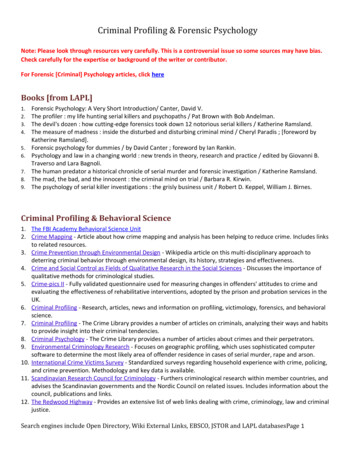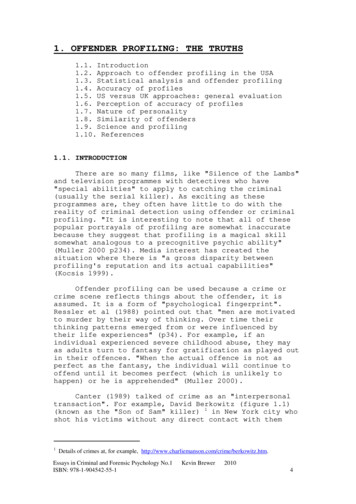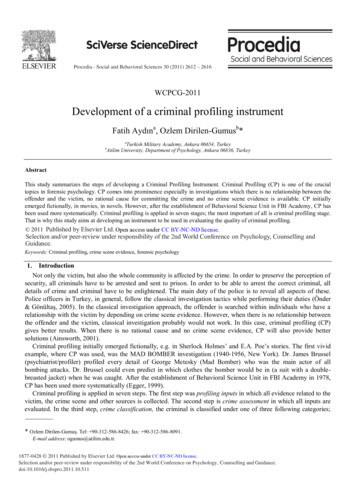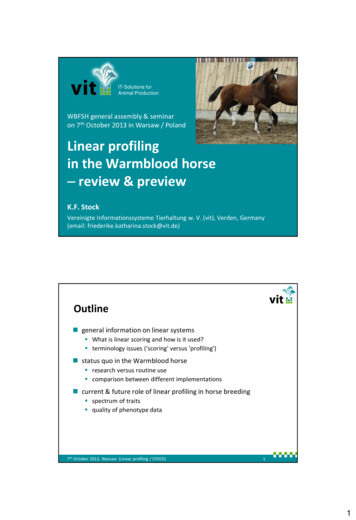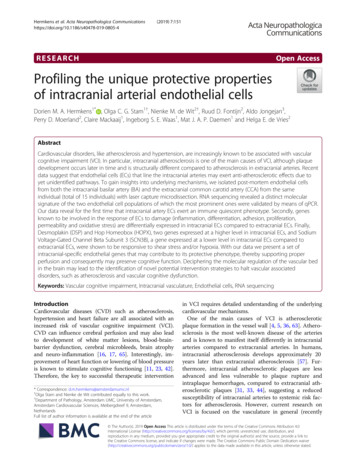
Transcription
Hermkens et al. Acta Neuropathologica 805-4(2019) 7:151RESEARCHOpen AccessProfiling the unique protective propertiesof intracranial arterial endothelial cellsDorien M. A. Hermkens1* , Olga C. G. Stam1†, Nienke M. de Wit2†, Ruud D. Fontijn2, Aldo Jongejan3,Perry D. Moerland2, Claire Mackaaij1, Ingeborg S. E. Waas1, Mat J. A. P. Daemen1 and Helga E. de Vries2AbstractCardiovascular disorders, like atherosclerosis and hypertension, are increasingly known to be associated with vascularcognitive impairment (VCI). In particular, intracranial atherosclerosis is one of the main causes of VCI, although plaquedevelopment occurs later in time and is structurally different compared to atherosclerosis in extracranial arteries. Recentdata suggest that endothelial cells (ECs) that line the intracranial arteries may exert anti-atherosclerotic effects due toyet unidentified pathways. To gain insights into underlying mechanisms, we isolated post-mortem endothelial cellsfrom both the intracranial basilar artery (BA) and the extracranial common carotid artery (CCA) from the sameindividual (total of 15 individuals) with laser capture microdissection. RNA sequencing revealed a distinct molecularsignature of the two endothelial cell populations of which the most prominent ones were validated by means of qPCR.Our data reveal for the first time that intracranial artery ECs exert an immune quiescent phenotype. Secondly, genesknown to be involved in the response of ECs to damage (inflammation, differentiation, adhesion, proliferation,permeability and oxidative stress) are differentially expressed in intracranial ECs compared to extracranial ECs. Finally,Desmoplakin (DSP) and Hop Homeobox (HOPX), two genes expressed at a higher level in intracranial ECs, and SodiumVoltage-Gated Channel Beta Subunit 3 (SCN3B), a gene expressed at a lower level in intracranial ECs compared toextracranial ECs, were shown to be responsive to shear stress and/or hypoxia. With our data we present a set ofintracranial-specific endothelial genes that may contribute to its protective phenotype, thereby supporting properperfusion and consequently may preserve cognitive function. Deciphering the molecular regulation of the vascular bedin the brain may lead to the identification of novel potential intervention strategies to halt vascular associateddisorders, such as atherosclerosis and vascular cognitive dysfunction.Keywords: Vascular cognitive impairment, Intracranial vasculature, Endothelial cells, RNA sequencingIntroductionCardiovascular diseases (CVD) such as atherosclerosis,hypertension and heart failure are all associated with anincreased risk of vascular cognitive impairment (VCI).CVD can influence cerebral perfusion and may also leadto development of white matter lesions, blood-brainbarrier dysfunction, cerebral microbleeds, brain atrophyand neuro-inflammation [16, 17, 65]. Interestingly, improvement of heart function or lowering of blood pressureis known to stimulate cognitive functioning [11, 23, 42].Therefore, the key to successful therapeutic intervention* Correspondence: d.m.hermkens@amsterdamumc.nl†Olga Stam and Nienke de Wit contributed equally to this work.1Department of Pathology, Amsterdam UMC, University of Amsterdam,Amsterdam Cardiovascular Sciences, Meibergdreef 9, Amsterdam,NetherlandsFull list of author information is available at the end of the articlein VCI requires detailed understanding of the underlyingcardiovascular mechanisms.One of the main causes of VCI is atheroscleroticplaque formation in the vessel wall [4, 5, 36, 63]. Atherosclerosis is the most well-known disease of the arteriesand is known to manifest itself differently in intracranialarteries compared to extracranial arteries. In humans,intracranial atherosclerosis develops approximately 20years later than extracranial atherosclerosis [57]. Furthermore, intracranial atherosclerotic plaques are lessadvanced and less vulnerable to plaque rupture andintraplaque hemorrhages, compared to extracranial atherosclerotic plaques [31, 33, 44], suggesting a reducedsusceptibility of intracranial arteries to systemic risk factors for atherosclerosis. However, current research onVCI is focused on the vasculature in general (recently The Author(s). 2019 Open Access This article is distributed under the terms of the Creative Commons Attribution 4.0International License (http://creativecommons.org/licenses/by/4.0/), which permits unrestricted use, distribution, andreproduction in any medium, provided you give appropriate credit to the original author(s) and the source, provide a link tothe Creative Commons license, and indicate if changes were made. The Creative Commons Public Domain Dedication o/1.0/) applies to the data made available in this article, unless otherwise stated.
Hermkens et al. Acta Neuropathologica Communications(2019) 7:151reviewed in [14, 26]) and does not describe the specificrole of the intracranial arteries.Endothelial cells (ECs) form a single cell layer that linesall blood vessels and regulates exchange between thebloodstream and surrounding tissues. Intracranial ECsdisplay an increased antioxidant enzyme activity and astrong blood-brain-barrier that protect the brain vasculature and the underlying brain parenchyma from diseasedevelopment [9]. To unravel the role of intracranial ECsin cerebral vascular functioning on a molecular level, several studies have analyzed the transcriptome of brainmicrovascular ECs, mostly in mice [20, 24, 28, 32, 48, 60].So far, only a limited number of studies describing thetranscriptome of human astrocytes, microglia, neurons, oligodendrocytes, pericytes and endothelial cells has beenperformed [8, 52, 56, 66]. To date, all studies on humanbrain samples are focused on the microvasculature of thebrain. Although the larger intracranial arteries are key inatherosclerotic plaque formation and consequently VCIdevelopment, data on the transcriptome of the ECs of theintracranial arteries are lacking. Uncovering the endothelial mechanisms that contribute to intrinsic atheroprotective properties and thus to lowering of the localintracranial atherosclerotic plaque burden, might be keyto healthy cerebral vascular functioning.With our study we are the first to unravel the distinct molecular pathways of intracranial artery endothelial cells in humans in order to identify novelpathways possibly involved in the protective nature ofthese ECs in the development of atherosclerosis andVCI. The paired comparison of the ECs derived fromPage 2 of 16the intracranial artery as well as from the extracranialartery has to our knowledge not been performed before and will be addressed here. The identification ofprotective pathways in the vascular bed of the brainis a first step towards novel early interventionstrategies to counteract brain endothelial associateddiseases like atherosclerosis and VCI.Materials & methodsPatient materialWe obtained post-mortem samples from the commoncarotid artery (CCA) and the basilar artery (BA) from 15individuals, who were autopsied at the AmsterdamUMC in the period between February 2015 and July2016. Inclusion criteria were 1) all individuals wereadults, 2) time between death and autopsy (post-mortemdelay, PMD) was less than 72 h and 3) written permission to obtain the materials at autopsy for research purposes was granted by the family of the patients. Age,gender, cause of death and PMD were documented inTable 1. The criteria for the code of proper secondaryuse of human tissue in the Netherlands were met[Human tissue and medical research: code of conduct forresponsible use. Federation of Dutch Medical ScientificSocieties]. During autopsy the circle of Willis and the carotids were exposed and macroscopically normal partsof the CCA and BA were sampled. The materials werestored in containers and frozen immediately using liquidnitrogen. After autopsy the samples were stored in afreezer at 80 C.Table 1 Patient characteristics with patient age, sex, cause of death and post-mortem delay. Patient 1–9 were used for RNAsequencing, patient 10–15 for biological validation. The cause of death of 4 patients is unknown, since the arteries for the studywere donated anonymously and only age, gender and post mortem delay were availablePatient numberAge (years)Sex (male/female)Cause of deathPost mortem delay (hours)160mALS 24259mALS 12378munknown 12487fStroke nown24–48968mALS 241069mSepsis fStroke48–721488fUnknown48–721559mUnknown 24
Hermkens et al. Acta Neuropathologica Communications(2019) 7:151Cryosectioning and hematoxylin stainingThe artery specimen were embedded with Tissue Tek(Tissue-Tek O.C.T Compound, Sakura) and liquid nitrogen on cryomolds. The membrane slides (MembraneSlide 1.0 PEN, Carl Zeiss Microscopy GmbH) werepretreated with UV light for 15 min. Frozen sections of8 μm were cut and mounted on the slides. The slideswere stored at 80 C. To enhance the visibility of theEC, the frozen sections were stained with hematoxylin(Mayer’s hematoxylin Solution, Sigma Aldrich). To prevent the slides from defrosting, the hematoxylin, ethanolsolutions and xylene were precooled. The slides werestained and dehydrated with graded ethanol solutions(75, 95 and 100%) ending with xylene. Afterwards theslides were allowed to dry for a maximum of 5 min inthe hood. The stained slides were stored at 80 C.Page 3 of 16adapters, and PCR amplification of the resulting productwas performed according to the procedure described inthe NEBNext Ultra DNA Library Prep kit for IlluminaInstruction Manual. The quality and yield after samplepreparation was measured with the Fragment Analyzer.The size of the resulting product was consistent with theexpected size of approximately 500–700 base pairs. Clustering and DNA sequencing using the Illumina NextSeq500 was performed according to manufacturer’sprotocols. A concentration of 1.6 pM of library wasused. NextSeq control software 2.2.0 was used. Imageanalysis, base calling, and quality check was performedwith the Illumina data analysis pipeline RTA v2.4.11 andBcl2fastq v2.20.RNA sequencing data analysisLaser capture microdissectionLaser capture microdissection (LCM6, Leica) was usedto isolate the endothelial cells. At a 100x magnificationthe arteries were scanned for areas were the endotheliallining was intact and at 200x magnification the areaswere selected for laser dissection. Areas which showedinflammation or accumulation of macrophages were excluded. In order to prevent the laser beam from damaging the EC layer, the cut was made directly underlyingthe luminal ECs. Damaged endothelium, defined as anon-continuous endothelial layer, was excluded. Thesamples were collected in extraction buffer (PicoPureRNA isolation kit (ThermoFisher) in a RNA-free microcentrifuge tube.RNA isolation and cDNA amplificationRNA isolation was performed using the PicoPure RNAisolation kit (ThermoFisher) using the manufacturers’instructions. After incubating for 30 min at 42 C, thesample was centrifuged at 800 x g for 2 min and storedat 80 C. Ethanol (70%) was added in a 1:1 ratio to thecell extract. For optimal precipitation, samples werestored for 30 min. at 20 C before adding to the purification column. DNAse treatment was performed on thepurification column. RNA was eluted in a volume of11 μl. For cDNA synthesis we used the Ovation RNASeq System V2 (Nugen) using the manufacturers’ instructions. Purification of SPIA cDNA was performedwith the QIAquick PCR Purification Kit (Qiagen).RNA sequencingRNA sequencing was performed by Service XS (GenomeScan) using the Illumina Next Generation SequencingTechnology. The NEBNext Ultra II DNA Library Prepkit for Illumina (cat# NEB #E7645S/L) was used toprocess the samples. Fragmentation of the DNA usingthe Biorupor Pico (Diagenode), ligation of sequencingA dataset with a mean of 1.9 Gb (25.8 million reads) ofIllumina-filtered single end 75 base pairs sequence datawas generated per sample. Data analysis was performedusing R (v3.3.1) and Bioconductor (v3.4). Raw sequencing data were subjected to quality control using rojects/fastqc/), dupRadar [50], Picard Tools (http://broadinstitute.github.io/picard/) and trimmed using ge trimmomatic). Reads were aligned to the human reference genome hg38 using HISAT2 (v2.0.4; fter alignment, samples of two individuals were excluded due to low read coverage. Possible mRNA degradation of the remaining samples was assessed byquantifying the 3′ bias of each gene using mRIN [12].The summary mRIN values of the samples from theremaining 9 individuals showed no significant RNA degradation (P-value 0.05) (Additional file 1: Table S1)and no correlation between PMD and mRIN values(Additional file 1: Figure S3).Gene level counts were obtained using HTSeq (v0.6.1;https://github.com/simon-anders/htseq) and the humanGTF from Ensembl (release 85; excluding mitochondrialencoded genes). Statistical analyses were performed usingthe edgeR and limma R/Bioconductor packages [43, 45].Genes with more than 5 counts in 6 or more samples wereretained. Count data were transformed to log2-counts permillion (logCPM), normalized by applying the trimmedmean of M-values method and precision weighted usingvoom [30]. Differential expression was assessed using anempirical Bayes moderated t-test within limma’s linearmodel framework including individual as a blocking variable. Resulting P-values were corrected for multiple testingusing the Benjamini-Hochberg false discovery rate (FDR).Additional gene annotation was retrieved from Ensembl(release 89) using the biomaRt R/Bioconductor package.
Hermkens et al. Acta Neuropathologica Communications(2019) 7:151Raw sequence data will be available in the EuropeanGenome-Phenome Archive (EGA) and upon request.Gene set enrichment analysis was performed usingCAMERA (limma package) with preset value of 0.01 forthe inter-gene correlation using gene set collectionsHallmark, C2 (curated), C3 (motifs), C5 (gene ontology),C6 (oncogenic) and C7 (immunologic) retrieved fromthe Molecular Signatures Database (MSigDB v6.0; EntrezGene ID version) [55, 64]. Resulting P-values were corrected for multiple testing using the BenjaminiHochberg FDR. For functional annotation of genes related to EC damage the following gene ontology (GO)terms were used: regulation of vascular permeability(go:0043114), response to oxidative stress (go:0006979),inflammatory response (go:0006954), endothelial celldifferentiation (go:0045446), regulation of endothelialcell proliferation (go:0001936), regulation of cell adhesion (go:0030155), regulation of cellular response tohypoxia (go:1900037). For functional annotation of genesrelated to perfusion the following terms were used: regulation of blood pressure (go:0008217), regulation ofblood circulation (go:1903522), mechanosensory behavior (go:0007638), mechanoreceptor differentiation (go:0042490), response to fluid shear stress (go:0034405).For functional annotation of genes related to cognitionthe following terms were used: cognition (go:0050890),alzheimers disease (hsa05010, gse1297), aging brain(gse1572, gse1572).RT-qPCRFor validation of the human samples, qPCR was performed on a BioRad CFX384 machine with the ssoFastEvaGreen method (Biorad). Expression levels of transcripts were obtained with LinRegPCR [41, 46]. Expression levels were normalized against CD31 and vWFexpression levels, as these genes are the most stablegenes between BA and CCA samples, analyzed withgeNorm module of qbase [22, 47] (Additional file 1:Figure S1). qPCR on cell culture samples was performedon a BioRad CFX384 machine with the SensiFASTSYBR Green method (Bioline). Expression levels oftranscripts were obtained with LinRegPCR [41, 46]. Forthe shear stress analysis the transcript levels were normalized against Rplp0 and β-actin and for the normoxiahypoxia analysis against B2M [35]. All primer sequencesare listed in Additional file 1: Table S2.In vitro cell cultureThe human brain endothelial cell line hCMEC/D3 waskindly provided by Prof. dr. Couraud (Institute Cochin,University Paris Descartes, Paris, France). Cells weregrown in EGM-2 medium (Lonza, Basel, Switzerland).Cells were subjected to unidirectional laminar shearPage 4 of 16stress essentially as described [10], with the followingmodifications. Cells were cultured on collagen type 1coated parallel plate flow chambers (μ-Slide I 0.4 luer,Ibidi, Martinsried, Germany) and exposed to calibratedshear stress levels of 10 dyne/cm2 and 0.74 dyne/cm2during 4 days using the Ibidi pump system (Ibidi, Martinsried, Germany). Culturing of cells under hypoxicconditions at 1% oxygen was performed as describedpreviously [34].ImmunocytochemistryFor immunocytochemical analysis of the human brainendothelial cell culture, cells were fixated with 4%paraformaldehyde, permeabilized with 0,1% Triton inPBS for 10 min and non-specific binding was blockedwith 10% normal goat serum (X0907, DAKO, SantaClara, CA, USA) for 30 min. Subsequently cells wereincubated overnight at 4 C with primary antibodiesagainst CD31 (DAKO, M0823) and HOPX (Invitrogen, PA-72855), SCN3B (Sigma, HPA04707) or DSP(Sdix, 2282.00.02). Secondary antibodies against goatanti-rabbit Alexa633 (Invitrogen, A-21070) and goatanti-mouse IgG1 Alexa568 (Invitrogen, A-21124) together with Hoechst for nuclei staining were incubated for 1 h at room temperature. The representativeimages were taking using a Leica TCS SP8 X microscope (63x objective, Leica Microsystems, Wetzlar,Germany).ImmunohistochemistryFor immunohistochemical analysis of the human brainmicrovasculature, 5 μm cryosections mounted oncoated glass slides (Menzel Gläser Superfrost PLUS,Thermo Scientific, Braunschweig Germany), were airdried and fixated in acetone for 10 min. Sections wereincubated for 30 min with 10% normal goat serum.Subsequently, sections were incubated overnight at4 C with primary antibodies against HOPX (Invitrogen, PA-72855), SCN3B (Sigma, HPA04707) or DSP(Sdix, 2282.00.02). Subsequently, the secondary antibody goat anti-rabbit Alexa 488 (Life Technologies)was incubated for 1 h. ULEX (Vector Labs) was usedas an endothelial cell marker and detected usingAlexa 555 labeled streptavidin (Life Technologies). Finally, sections were stained with Hoechst (MolecularProbes) to visualize cellular nuclei and mounted withMowiol mounting medium. The representative imageswere taken using a Leica DM6000 microscope (40xobjective, Leica Microsystems).For immunohistochemical analysis of the human BA,5 μm formalin fixed paraffin tissue was mounted oncoated glass slides and dewaxed with xylene and rehydrated trough graded ethanol solutions to water. Antigenretrieval was performed at 98 C for 20 min in a Lab
Hermkens et al. Acta Neuropathologica Communications(2019) 7:151Page 5 of 16Fig. 1 Laser capture microdissection of macroscopically normal CCA and BA (a) Cross-sections of macroscopically normal CCA and BA, depictedwith Hematoxylin and Eosin staining. Scale bar for CCA and BA represents resp. 1200 and 300 μm. b Vessel wall of BA (left, marked by CD31 inbrown, scale bar represents 120 μm) and higher magnification vessel wall (right) with selected area depicting representative LCM cutting marginsfor EC collection. c Significant differential expression of eNOS and ZO1 between the BA and CCA measured by qPCR. d No significant differenceof smooth muscle cell (ACTA2) and fibroblast (S100A4, Col1A2, Col3A1, VIM) marker expression in LCM-collected population of the BA comparedto the CCA samples. c, d Data are depicted as expression level normalized against CD31 and vWF. Significance level determined by Wilcoxonsigned rank test, p 0.05 (*) and p 0.01 (**) considered significant. n 11 patients. ACTA2 Actin alpha 2, CD31 Cluster of differentiation 31,Col1A2 Collagen type I alpha 2, Col3A1 Collagen type Ill alpha 1, eNOS endothelial Nitric Oxide Synthase, S100A4 S100 Calcium BindingProtein A4/Fibroblast specific protein 1, VIM Vimentin, ZO1 Zona Occludens Protein 1Vision PT-module (ThermoFisher) with Tris-EDTA(TA-250-PM4x, ThermoFisher; pH 9). The tissue wasblocked with Super Block (AAA999, Scytech, Logan,UT, USA) for 10 min at room temperature. Where afterthe tissues were incubated with primary antibodiesagainst CD31 (DAKO, M0823) and HOPX (Invitrogen,PA-72855), SCN3B (Sigma, HPA04707) or DSP (Sdix,2282.00.02) overnight at 4 C. Secondary antibodiesgoat-anti-rabbit Alexa633 (Invitrogen, A-21070) andgoat-anti-mouse IgG1 Alexa568 (Invitrogen, A-21124)together with Hoechst were applied for 30 min at roomtemperature. Sections were mounted with Prolong gold(P36935, ThermoFisher) and representative images weretakes using a Leica TCS SP8 X microscope (40x objective, Leica Microsystems, Wetzlar, Germany).ResultsLaser capture microdissection of human intra- vs.extracranial arterial ECsAnalyses were performed on paired post-mortem derived ECs of the intracranial basilar artery (BA) and theextracranial common carotid artery (CCA). The postmortem samples were derived from 15 individuals withdistinct causes of death and age ranging from 32 years to88 years (Table 1). To specifically detect intrinsic differences in gene expression between intra- and extracranialECs, rather than disease associated characteristics, analyses were performed by comparing macroscopicallynormal tissues of intra- and extracranial origin withineach individual (Fig. 1a). Laser microdissection was usedto isolate the ECs (Fig. 1b).
Hermkens et al. Acta Neuropathologica Communications(2019) 7:151Page 6 of 16Fig. 2 Differential regulation of immune- and EC damage response genes in the ECs of the BA compared to the CCA (a) Heatmap of the 593differentially expressed genes (absolute log2-fold-change 2 and adjusted P-value 0.05). Dendrogram using Euclidean distance and completelinkage. Color coding corresponds to z-score of logCPM values from blue (downregulated) to red (upregulated). b Volcano plot with black dotsdepicting individual genes. In red, genes that were also found to be upregulated by IFNγ in a published dataset (MSigDB ID: M4551) [49]. Solidred line corresponds to a P-value 0.05. Dotted red lines correspond to an absolute log2-fold-change of 1. c Venn diagram with genes related toEC damage response with absolute log2-fold-change 2 and p-value 0.05. Numbers in grey are total genes in subgroup, in red are the geneshigher expressed in the BA, in green the genes higher expressed in the CCAIn order to validate the selection of ECs and the differential expression between the BA and the CCA, we performed qPCR analysis of genes known to be highlyexpressed in intracranial ECs, such as Zona Occludens 1(ZO1) and Endothelial Nitric Oxide Synthase 3 (eNOS)[6, 19]. We found a higher expression of ZO1 and eNOSin the intracranial artery ECs compared to extracranialartery ECs (Fig. 1c), whereas Platelet and EndothelialCell Adhesion Molecule 1 (PECAM1/CD31) and vonWillebrand factor (vWF) were equally expressed between the two locations (and used as reference genes,Additional file 1: Figure S1).By selecting the ECs with laser microdissection, oursamples could contain a subset of non-endothelial transcripts. To rule out differences in the non-endothelialsubpopulation between the BA and the CCA samples,we performed qPCR for several non-endothelial markers.Gene expression of smooth muscle cells and fibroblast
Hermkens et al. Acta Neuropathologica Communications(2019) 7:151Page 7 of 16Table 2 Enrichment of molecular function and cellular component GO-terms in BA and CCA ECs. Top 5 GO molecular function andcellular component terms higher expressed in the BA compared to the CCA and vice versa. FDR is false discovery rate.0020Gene set enrichment analysis on GO molecular function termsTop 5 GO-terms higher expressed in basilar artery compared to carotid arteryMolecular functionP-valueFDRGO:0003735STRUCTURAL CONSTITUENT OF RIBOSOME6.27E-073.51E-04GO:0003743TRANSLATION INITIATION FACTOR ACTIVITY9.51E-062.31E-03GO:0044822POLY A RNA BINDING7.67E-059.26E-03GO:0016675OXIDOREDUCTASE ACTIVITY ACTING ON A HEME GROUP OF DONORS2.00E-041.65E-02GO:0045182TRANSLATION REGULATOR ACTIVITY2.11E-041.67E-02G0-termTop 5 GO-terms higher expressed in carotid artery compared to basilar arteryMolecular functionP-valueFDRGO:0042605PEPTIDE ANTIGEN BINDING6.42E-058.68E-03GO:0008329SIGNALING PATTERN RECOGNITION RECEPTOR ACTIVITY4.08E-042.55E-02GO:0004896CYTOKINE RECEPTOR ACTIVITY8.94E-043.92E-02GO:0001653PEPTIDE RECEPTOR ACTIVITY1.24E-034.74E-02GO:00041153 5 CYCLIC AMP PHOSPHODIESTERASE ACTIVITY1.40E-035.10E-02G0-termGene set enrichment analysis on GO cellular component termsTop 5 GO-terms higher expressed in basilar artery compared to carotid arteryCellular componentP-valueFDRGO:0044391RIBOSOMAL SUBUNIT8.67E-081.02E-04GO:0022626CYTOSOLIC RIBOSOME9.69E-081.02E-04GO:0015934LARGE RIBOSOMAL .02E-04GO:0015934CYTOSOLIC LARGE RIBOSOMAL SUBUNIT2.99E-072.02E-04P-valueFDRG0-termTop 5 GO-terms higher expressed in carotid artery compared to basilar arteryG0-termCellular componentGO:0042611MHC PROTEIN COMPLEX1.90E-067.49E-04GO:0042613MHC CLASS II PROTEIN COMPLEX5.47E-058.05E-03GO:0032281AMPA GLUTAMATE RECEPTOR COMPLEX2.00E-041.65E-02GO:0061702INFLAMMASOME COMPLEX3.85E-042.49E-02GO:0005858AXONEMAL DYNEIN COMPLEX4.33E-042.63E-02components was not significantly different between theBA and CCA (Fig. 1d).An immunoquiescent- and damage protective phenotypeof the intracranial artery ECsWe performed RNA sequencing on the ECs of the BAand CCA of nine individuals. Despite the post-mortemnature, the samples of these nine patients did not showsignificant RNA degradation (P-value 0.05) (Additionalfile 1: Table S1). Differential gene expression revealedthat 900 genes were differentially expressed with absolute log2 fold-change 2 and P-value 0.05, and 593genes were differentially expressed with absolute log2fold-change 2 and adjusted P-value 0.05 (Fig. 2a).Gene set enrichment analysis on GO molecular functionterms showed that proteins encoded by the genes thatwere expressed to a higher level in the BA ECs aremainly involved in ribosome functioning and translation.In addition, genes higher expressed in the CCA ECs aremainly involved in antigen binding and receptor activity.Furthermore enrichment analysis on GO cellular component terms confirmed enrichment of ribosomal transcripts in the BA, whereas the genes enriched in theCCA are involved in inflammation (Table 2). This analysis indicates that ECs from intracranial and extracranial arteries differ in their molecular functions.Gene set enrichment analysis also identified a topranked gene set consisting of genes upregulated in primary endothelial cell types (lung, aortic, iliac, dermal,and colon) treated with Interferon-gamma (IFNγ)(MSigDB ID: M4551) [49]. Almost all genes upregulatedby IFNγ were higher expressed in the extracranial ECs
Hermkens et al. Acta Neuropathologica Communications(2019) 7:151compared to the intracranial ECs (Fig. 2b and Additionalfile 1: Table S3A), which suggests specific regulation ofthe intracranial ECs resulting in an anti-inflammatoryphenotype. This fits with earlier in vitro data showing animmunoquiescent state of brain microvascular ECs [59],supporting the hypothesis that intracranial ECs have amore protective phenotype to resist damage.Fig. 3 (See legend on next page.)Page 8 of 16To further unravel the molecular pathways involved inthe protective nature of the intracranial ECs, we focusedon genes involved in EC damage. For this, we analyzedthe 900 differentially expressed genes with absolutelog2-fold-change 2 and p-value 0.05 (correspondingto adjusted p-value 0.236) for their involvement in thefollowing EC damage responses: inflammation,
Hermkens et al. Acta Neuropathologica Communications(2019) 7:151Page 9 of 16(See figure on previous page.)Fig. 3 A role for DSP, HOPX and SCN3B in EC shear stress and/or hypoxia regulation (a) Venn diagram of differentially expressed genes that areinvolved in cognition (118 genes), perfusion (48 genes) or both (15 genes, underscored) with absolute log2-fold-change 2 and p-value 0.05. bVolcano plot of RNA sequencing data with black dots depicting individual genes. In red the genes differentially expressed and involved in perfusionand cognition. Solid red line corresponds to a P-value 0.05. Dotted red lines correspond to an absolute log2-fold-change of 1. c Technical andbiological validation with qPCR of one representative gene (n 3 technical replicates). Patients 1, 3, 5 were used in RNA sequencing experiment(technical validation), patient 11, 12, 13, 15 were not used in RNA sequencing experiment (biological validation). Expression is normalized against CD31and vWF expression. Dashed line indicates two independent experiments. d The effect of shear stress conditions on gene expression. KLF2 and THBDare used as positive controls. SCN3B and DSP are significantly downregulated upon shear stress conditions (n 3–5 shear stress experiments, Friedmantest). static 0 dyne/cm2, low 0.75dyne/cm2, high 10dyne/cm2. Expression of individual genes is normalized against Rplp0 and B-actin expressionand compared to the static condition. e The effect of hypoxic conditions on gene expression. VEGFA is used as positive control. SCN3B and HOPX aresignificantly upregulated upon hypoxia (n 5 hypoxia experiments, Paired t-test). Normoxia 20% O2, hypoxia 1% O2. Expression of individual genesis normalized against B2M expression and compared to the normoxia condition. c, d and e Mean with SEM is depicted. d, e Significance level of p 0.05 (*), p 0.01 (**) and p
samples were collected in extraction buffer (PicoPure RNA isolation kit (ThermoFisher) in a RNA-free micro-centrifuge tube. RNA isolation and cDNA amplification RNA isolation was performed using the PicoPure RNA isolation kit (ThermoFisher) using the manufacturers' instructions. After incubating for 30min at 42 C, the



